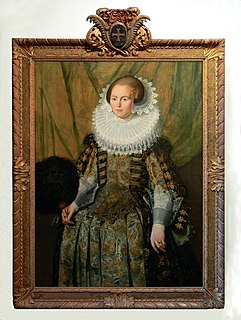Related Research Articles

Maria Catherina van der Linden-Swanenburg was a Dutch serial killer who murdered at least 27 people and was suspected of killing more than 90 people.
Maria Thins was the mother-in-law of Johannes Vermeer and a member of the Gouda Thins family.

Catharina Belgica of Nassau was a countess of Hanau-Münzenberg by marriage to Philip Louis II, Count of Hanau-Münzenberg. She was regent of Hanau-Münzenberg during the minority of her son from 1612 until 1626.

Countess Elisabeth of Nassau was the second daughter of prince William of Orange and his third spouse Charlotte of Bourbon, and Duchess of Bouillon by marriage to Henri de La Tour d'Auvergne. She was the regent of Sedan during the absence of her spouse; between 1623 and 1626 during the minority of her son; and from 1632 during the absence of her son.

Countess Charlotte Brabantina of Nassau was the fifth daughter of William the Silent and his third spouse, Charlotte of Bourbon. She lived in her life at the French royal court and performed many successful assignments as a mediator.

Alida Withoos was a Dutch botanical artist and painter. She was the daughter of the painter Matthias Withoos.

Henriette Catherine of Nassau was princess consort of Anhalt-Dessau by marriage to John George II, Prince of Anhalt-Dessau, and regent of Anhalt-Dessau from 1693 to 1698 during the minority of her son Leopold I, Prince of Anhalt-Dessau.

Olivia Mariamne Devenish, was the spouse of Thomas Stamford Raffles, vice governor of Java (1811–1816), from 1805 to 1814. A memorial monument was erected to her memory in the botanical garden of Buitenzorg (Bogor).
Susanna du Plessis (1739–1795) was a plantation owner in Dutch Surinam. She is a legendary figure in the history of Surinam, where she has become a metaphor of a cruel and sadistic slave owner. She is the subject of songs, plays, fairy tales and legends as well as books.

Cornelia van Nijenroode was a Dutch merchant in the Dutch East Indies, famous for her conflict with her second husband. She is the subject of Leonard Blussé's Bitter Bonds: A Colonial Divorce Drama of the Seventeenth Century.

Catharina Knibbergen was a Dutch Golden Age landscape painter.
Angelina Catharina Valentijn, also Anjelina van Batavia, (1768-1817) was born a slave in Batavia, Dutch East Indies, who after she was freed, accumulated remarkable financial and territorial wealth through her marriages.
Elisabeth Abbema, was a Dutch governor's wife.
Catharina Johanna Koek (1763–1843), was a Dutch governor's wife. She is depicted in history as a typical example of the Dutch colonial customs in Dutch East Indies and how it was viewed by Europeans.

Eva Ment, was a Dutch governor's wife.
Catharina Herman was a Dutch heroine of the Eighty Years' War. She was hailed in history as a role model of marital fidelity.
Catharina de Grebber was a Dutch woman. She is known as the victim of a famous case of kidnapping and rape in the Netherlands in 1515. The case was widely famed in the contemporary Netherlands, where it was published and popular within literature: it was also the subject of a song, where Catharina de Grebber was described as a rabbit persecuted by a hunter.
Catharina de Chasseur also known as Catherine le Sasseure and Catherine Dechassoir, was a Dutch counterfeiter. She was the central figure of a famous criminal court case which has often been referenced in Dutch literature.
Charlotte Amélie de La Trémoille was a memoirist and courtier. She was a lady-in-waiting to the queen of Denmark, Charlotte Amalie of Hesse-Kassel, and known as a favorite and confidante of the queen.

Geertruida Catharina Theresia Maria "Truus" Smulders-Beliën was a Dutch politician and teacher who was the mayor of Oost-, West- en Middelbeers in North Brabant from 1946 to 1966. The first female mayor in the Netherlands, she succeeded her husband Jan Smulders after he was executed by Nazi soldiers.
References
- Lilian de Bruijn, Yvonne Prins, Besselman, Catharina, in: Digitaal Vrouwenlexicon van Nederland. URL: http://resources.huygens.knaw.nl/vrouwenlexicon/lemmata/data/Besselmans [13/01/2014]